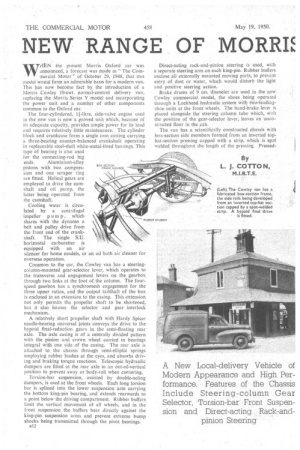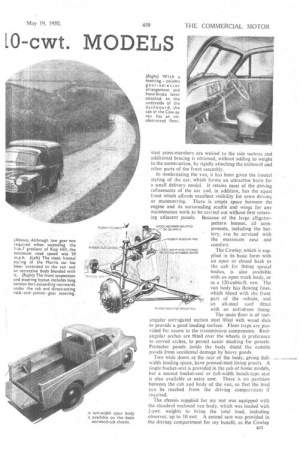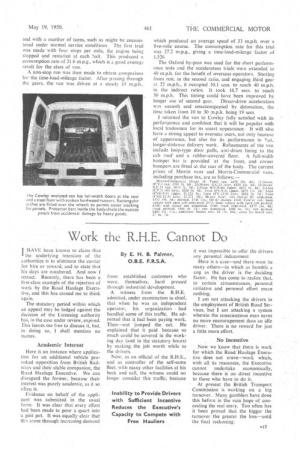NEW RANGE OF MOM 10-cwt. MODELS
Page 46

Page 47

Page 48

Page 51

If you've noticed an error in this article please click here to report it so we can fix it.
By 1. J. COTTON,
M.I.R.T.E. WrILN the present Morris Oxford car was announced, a forecast was made in "The Commercial Motor" of October 29, 1948, that this '
model woUid form an admirable basis for a modern van. This has now become fact by the introduction of a Morris Cowley 10-cwt. normal-control delivery van, replacing the Morris Series Y model and incorporating the power unitand a number of other components common to the Oxford car. •
The four-cylindered, 1k-litre, side-valve engine used in the. new. van is flow a -prOved unit which, because of
its adequate capacity, provides ample power for its load
and requires-relatively -little maintenance. The cylinder block and crankcase form A single iron casting carrying
a three-bearing counter-balanced crankshaft operating in replaceable steel-shell white-metal-lined bearings. This type of bearing is also used for the connecting-rod big ends. Aluminium-alloy pistons with two compression and one scraper ring are fitted. Helical, gears are employed to drive the camshaft and oil pump, the latter being operated from the camshaft.
Cooling water is eireu-. Sated by a centrifugal impeller p u m p, which shares with the dynamo a belt and pulley drive from the front end of the crankshaft. The single S.U. horizontal carburetter is equipped with an air . silencer for home models, or an oil bath air cleaner for overseas operation.
Common to the car, the Cowley van has a steeringcolumn-mounted gear-selector lever, which operates to , the transverse and engagement severs on the gearbox through two links at the foot of the Column. The fourspeed gearbox has a synchromesh engagement for the three upper ratios, and the output tailthaft of the box is enclosed in an extension to the casing. This extension not only permits the propeller shaft to be shortened, but it also houses the selector and gear interlock mechanism, .
A relatively short propeller shaft with Hardy Spicer needle-bearing universal joints conveys the drive to the hypoid final-reduction gears in the semi-floating rear axle. The axle casing is of a centrally divided pattern with the pinion and crown wheel carried in bearings integral with one side of the casing. The rear axle is attached to the chassis through semi-elliptic springs employing rubber bushes at the eyes, and absorbs driving and braking torque reactions. Telescopic hydraulic dampers are fitted at the rear axle in an out-of-vertical position to prevent sway or body-roll when cornering Torsion-bar suspension, assisted by double-acting dampers, is used at the front wheels. Each long torsion bar is splined into the lower suspension arm carrying the bottom king-pin bearing, and extends rearwards to a point below the driving compartment. Rubber buffers limit the vertical movement of all wheels, and in the front suspension the buffers bear directly against the king-pin suspension arms and prevent extreme bump shocks being transmitted through the pivot bearings,
BOX SECTION. FRAME MEMBER
Direct-acting rack-and-pinion steering is used, with a separate steering arm on each king-pin. Rubber buffers enclose all externally_ mounted moving parts, to prevent entry of dust or water, which would disturb the light and positive steering action.
Brake drums of 9 ins. "diameter are used in the new Cowley • commercial model, the shoes being operated through a Lockheed hydraulic system with two-leadingshoe units at the front wheels. The hand-brake lever is placed alongside the steering column tube which, with the position of the gear-selector lever, leaves an unob structed floor in the cab, .
The van has a scientifically constructed chassis with box-section side members formed from an inverted tophat-section pressing capped with a strip, which is spat welded throughout the length of the pressing. Pressed steel cross-members are welded to the side sectoris and additional bracing is obtained, without adding to weight in the construction, by rigidly attaching the toeboard and other parts of the front assembly.
In modernizing the van, it has been given the frontal styling of the car, which forms an attractive basis for a small delivery model. It retains most of the driving refinements of the car and, in addition, has the squat front which affords excellent visibility for town driving or manceuvring. There is ample space between the engine and its surrounding scuttle and wings for any maintenance work to be carried out without first removing adjacent panels. Because of the large alligatorpattern bonnet, all components, including the battery, can be serviced with SHOCK ABSORBER mouvrEn ON BULKHEAD RUEIBER REBOUND PAD the maximum ease and
comfort.
The Cowley, which is sup
TED 9, PABER GAITER plied in its basic form with
an open or closed back to
the cab for fitting special bodies, is also available with an open truck body, or as a 120-cubic-ft. van. The van body has flowing lines, which blend with the front part of the vehicle, and an all-steel roof fitted RUBBER MOUNTED STEADY ROD with an anti-drum lining
The main floor is of rect angular corrugated section steel filled with wood slats to provide a good loading surface. Floor traps are provided for access to the transmission components. Rectangular arches are fitted over the wheels in preference to curved arches, to permit easier stacking for parcels. Protector panels inside the body shield the outside panels from accidental damage by heavy goods.
Two wide doors at the rear of the body; giving
width loading space, have pressed-steel lining panels: A single bucket-seat is provided in the cab of home Models, but a second bucket-seat or full-width bench-type seat is also available at extra cost. There is no partition between the cab and body of the van, so that the load can be reached from the driving compartment if required.
The chassis supplied for my test was equipped with
the standard *enclosed van body, which was loaded with :I-cwt. weights to bring the total load, including observer, up to 10 cwt. A second seat was provided in the driving compartment for my benefit, as the Cowley
van as supplied, having only the driving seat. After securing the fuel test tank and Tapley gradient meter into position, I drove the van into Oxford to assess its merits under local delivery conditions.
Although the engine was cold and the' outside temperature only slightly over 40 degrees F., the engine started smoothly and showed no hesitation when given full throttle at low speed. Because of heavy rain the cab windows were kept closed and at the first corner I looked for the traffic-indicator switch. Unfortunately, this is one of the amenities which the van has not inherited from its private counterpart. In the absence of indicators, I prefer a quick-drop window on the driving side, but the Cowley van has a low-geared winding drop-window.
There was nothing lacking in the van's town performance, thanks to the lively engine and synchromesh gearbox. Additional features which enhance the cab's accessibility include steering-column gear change, and hand-brake lever mounted under the instrument panel, thus leaving the driving-compartment floor free from obstruction. I found the driving position well related to the wide front-hinged doors for rapid exit or ntrance.
Because the Cowley van has a lower-ratio axle than the car, its acceleration rate is equally as good, although maximum speed is slightly lower; even so. I noticed the van held 50 m.p.h. quite comfortably on a burst of speed between Oxford and Princes Risborough. When driving the van, I felt it was safe at all speeds. There al4 was no tendency to roll when cornering on badly cambered roads, and the brakes were adequate, whilst they gave no trace of pulling or locking the wheels. The rack-and-pinion steering is light, but well protected against shock by the independent suspension. There were occasions when tremors could be felt on the steering wheel, but only where the road surface was deeply rutted. Slightly more effort is required when steering round corners than with other vans of this class, but the self-return action is normal.
The radiator water temperature was recorded at the foot of Kop Hill, and the ascent of the I-mile long gradient made from a standing start. Moving away from rest in low gear, the subsequent indirect ratios were engaged within 50 yds. and held until -meeting the 1-in-7 section, at which point the engine speed fell rapidly. Changes to second and low gears were made in quick succession, bottom gear being engaged at 20 m.p.h. Although the incline is severe towards the top, the road speed never fell below 18 m.p.h. From start to finish, the climb occupied 2 mins. 6 secs., during which time the radiator water temperature rose from 162 to 179 degrees F., with an ambient of 40 degrees F The Cowley van has one more row of tubes in the radiator than has the Morris Oxford car, the cooling water remaining at a reasonable temperature. For operation in some countries overseas, cowling for the six-bladed fan might be called for.
A fuel-consumption trial was made on the return journey to Oxford over a road which was undulating and with a number of turns, such as might be encountered under normal service conditions. The first trial was made with four stops per mile, the engine bein,g stopped and restarted at each halt. This produced a consumption rate of 21.6 m.p.g., which is a good average result for the class of van.
A non-stop run was then made to obtain comparison for the time-load-mileage factor. After passim., through the gears. the van was driven at a steady 35 m.p.h.,
which produced an average speed of 33 mph. over a five-mile course. The consumption rate for this trial was 27.2 m.p.g., giving a time-load-mileage factor of 1,526.
The Oxford by-pass was used for the short performance tests and the acceleration trials were extended to 40 m.p.h. for the benefit of overseas operators. Starting from rest, in the second ratio, and engaging third gear at 22 m.p.h., it occupied 30.1 sees. to reach 40 m.p.h. in the indirect ratios. It took 16.7 secs, to reach 30 m.p.h. This timing could have been improved by longer use of second gear. Direct-drive acceleration was smooth and unaccompanied by detonation, the time taken from IQ to 30 m.p.h. being 19 secs.
I returned the van to Cowley fully satisfied with its performance and confident that it will be popular with local tradesmen for its smart appearance. It will also have a strong appeal to overseas users, not only be,cause of appearance, but also for its performance in fast, longer-distance delivery work. Refinements of the van include loop-type door pulls, anti-drum lining to the cab roof and a rubber-covered floor. A full-Width bumper bar is provided at the front, and ,corner bumpers.are fitted at the rear of the body. The current prices of Morris vans and Morris-Commercial vans, including purchase tax, are as follows:-
Morris-Corntnercial 10-cwt. (I. Type) van. £479 us. 4d.; 15-20-ewt. IP.V.) van, £591 Is. Sd.; 25-30-cwt. (L.C.3) tom. £525 18s. 4d.: 25-30-con (LC.3) van, £615 7s. 3d.; 2-3-ton (CV.9/401 tipper, £652 Ss 4d.; 2-3-ton (CV.11.140) lorry, £620 9s. 5d.; 5-ton (FV.9,3) tipper, .E1179 17s, 3d.; 5-ton (FV0.9/5) Coml., £1.323 5s.; 5-ton IFV.12;5) lorry. £828 2s. 3d.; 5-ton (FV0.1215) lorry. £1.271 10s.: Morris 5-pat, van ISeries Z). unpainted, £332 19s, 5d.; painted, £341 Us.; (D!.(s) chassis, 4:160; Cowley van, basic vehicle with open cab unpainted, £335; basic vehicle with oven cab painted. £3441; with closed cab unpainted, £3411; truck nripsInted, £479 185. 4d.: truck parriled. £486 6s Id.: van unpainted. £486 fis. Id.; van painted. £492 13s. lid.; additional bucket sear, £4 15; 10d.; extra for bench seat. £7 Os. 7d.




























































































